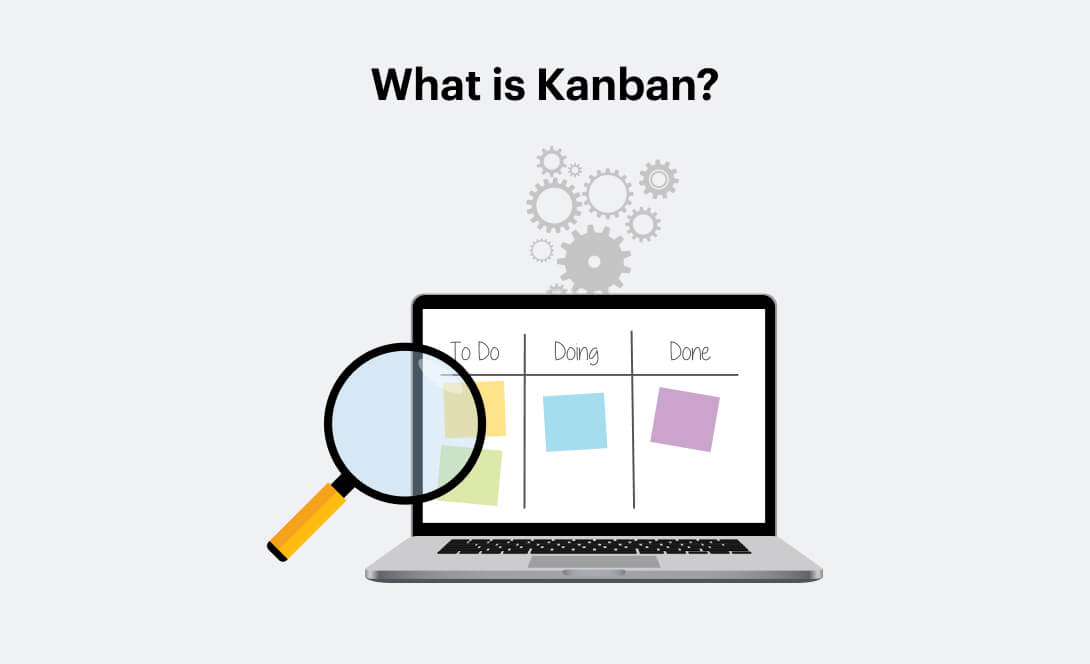You are in a fast-paced atmosphere if you work in the Agile business. Things can quickly become overpowering. It’s possible that you’re surrounded by dysfunctional teams that make staying on top of your work exhausting and challenging. That’s where the Kanban method comes in handy. It’s not the end-all solution for organized workflow and organizational efficiency, but it’s a step in the right direction. It may be difficult to do the job in a timely and efficient manner. The Kanban method proposes a method for managing workflow with a focus on continual improvement while without overburdening the development team’s productivity and efficiency.
What is Kanban?

Kanban is a popular framework for agile and DevOps software development. It allows real-time capacity communication and total work exposure. On a kanban board, work objects are visually shown, enabling team members to see the situation per amount of work at any point.
The kanban system is similar to a signal-and-response system. When an item at an operational station is running low, a visual signal will indicate how much to order from the supply. The individual who uses the parts places an order for the quantity specified by the kanban, and the supplier fulfills the order to the penny.
History of Kanban
Kanban is a Japanese management system that dates back to the 1940s. According to Toyota employees, supermarkets employed a primary but successful method based on little physical cards to notify when items were out of stock or needed to be ordered. They used this technique to visualize better work and control flow in their production process.
The insufficient productivity and efficiency of Toyota in comparison to its American automotive rivals was a major driving force behind the invention of Kanban. Toyota used Kanban to create a flexible and efficient just-in-time production control system that enhanced productivity while eliminating costly raw material, semi-finished material, and completed product inventory.
Benefits of the Kanban Methodology

Below defined are some of the most famous benefits of Kanban methodology –
Simplified operations having an easy production overview
When two people work on the same assignment, needless code can slow down software development. Kanban’s easy-to-understand visual overview aids in the reduction of waste. With a momentary glimpse at the Kanban board, it’s easy to tell who’s doing what, and there’s no need for comprehensive reporting. Every member of the team has a panoramic perspective. Project managers can also quickly figure out what each individual is up to.
Finer visibility
Visualization is a crucial Kanban technique, and the Kanban board is the Kanban method’s most identifiable aspect. Each project consists of a backlog of tasks to do, and each job must pass through a sequence of process phases before being delivered. Everyone can see how tasks are progressing using the Kanban board. As it clarifies its visual portrayal, bottlenecks may be clearly seen as they arise.
Flexible and responsive
Kanban is founded on the ‘just-in-time’ concept, making it adaptable to market fluctuations. Furthermore, it concentrates on current tasks and only adds new work from the top of the Backlog to the board after the present job is completed. As a result, the Project Manager can re-prioritize the Backlog without interrupting the flow. This enables PMs to align delivery with changing demand and respond to the organization’s, customers’, and market’s business needs. The development team may be confident of delivering maximum value as long as the essential tasks remain at the top of the Backlog.
Concentrate on your team’s efforts
It may appear that providing the development team with a comprehensive perspective of the process will divert their attention away from customized assignments. Kanban software development boards draw attention to themselves. The WIP constraints force you to focus on the task at hand until it’s completed. Production would not be able to continue if this were not the case.
Constant improvement & delivery
Continuous integration is necessary for quality assurance and continuous delivery. One of the advantages of Kanban is its ability to combine these two methods successfully. Kanban’s capacity to boost productivity and team concentration increases efficiency and lower costs. This enables teams to identify new strategies to improve their work and create better results.
Conclusion
Kanban is a popular methodology for Agile teams since there are many reasons to utilize it for software development. Software development teams can have a smoother approach in completing projects of any size by successfully employing Kanban. If you want to get any kind of Kanban assistance, you can contact us.








